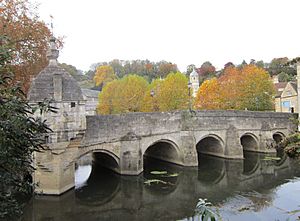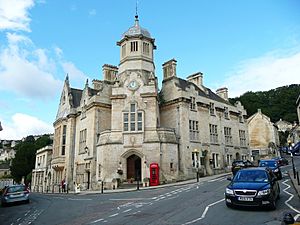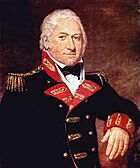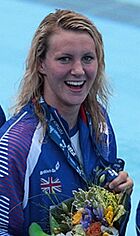Bradford-on-Avon facts for kids
Quick facts for kids Bradford-on-Avon |
|
|---|---|
 The Town Bridge over the river Avon. The small domed building is the lockup, where the town's troublemakers were put for the night. |
|
| Population | 10,405 (2021 Census) |
| OS grid reference | ST826609 |
| Civil parish |
|
| Unitary authority |
|
| Ceremonial county | |
| Region | |
| Country | England |
| Sovereign state | United Kingdom |
| Post town | BRADFORD-ON-AVON |
| Postcode district | BA15 |
| Dialling code | 01225 |
| Police | Wiltshire |
| Fire | Wiltshire |
| Ambulance | Great Western |
| EU Parliament | South West England |
| UK Parliament |
|
| Website | Town Council |
Bradford-on-Avon is a charming town in west Wiltshire, England. It's close to the border with Somerset. In 2021, about 10,405 people lived there.
This town is a favourite spot for visitors. People love its historic buildings, unique shops, and lovely canal. Its name comes from "Broad-Ford," meaning a wide place to cross the River Avon.
The town has a long history, going back to Roman times. Many buildings from the 17th century still stand. This was when the town became rich from making woollen textiles.
Contents
History of Bradford-on-Avon
The oldest signs of people living here are from the Roman era. Archaeologists have found parts of large Roman villas. One had a beautiful mosaic floor.
The town grew around a ford (a shallow place to cross) over the River Avon. Later, a stone bridge was built during Norman times. This bridge is still used today! The older Norman part has pointed arches. The newer part has curved arches.
This Town Bridge is a very important historic building. It was first a packhorse bridge, used by horses carrying goods. In the 17th century, it was made wider. During the English Civil War in 1643, soldiers fought here. Royalist troops took control of the bridge.
On the bridge, there's a small building. It was once a chapel but later became a lock-up. This was a place where people who caused trouble were held overnight. A weather vane on top looks like a gudgeon fish. This led to the local saying: "under the fish and over the water."
Wool Industry and Old Buildings
The river was very important for the town's wealth. It powered the wool mills. Many 17th-century buildings show how successful the local textile industry was. You can see great examples of weavers' cottages on Newtown, Middle Rank, and Tory Terraces.
A writer named Daniel Defoe visited in the 1700s. He said that cloth makers in the area were very rich. Some were worth a lot of money, which would be millions today! Many important families in the area became wealthy from this "noble manufacture."
As machines improved, wool weaving moved from homes to large mills. These mills were built next to the river. They used water and steam to power the looms. About thirty mills were built in Bradford-on-Avon. But by the late 1800s, the wool industry moved to Yorkshire. The last local mill closed in 1905. Many old mills are now modern flats.
A famous building here is the huge tithe barn. It's 180 feet long and 30 feet wide! It was built in the 14th century. Today, it's part of Barton Farm Country Park. A tithe barn was used to collect taxes, often in goods, to support the church.
Many old factories have been turned into modern homes. One of the few buildings still used for its original purpose is The Swan. It's a public house and hotel from the 17th century. Records show a pub has been on this spot since the 1500s.
The Hall is a grand Jacobean mansion. It was built around 1610 for John Hall, a rich mill-owner.
In 1998, the Wiltshire Music Centre opened. It's on the grounds of St Laurence School. In 2000, a sculpture nicknamed "Millie" was revealed. In 2003, Bradford-on-Avon became a Fairtrade Town.
Geography of Bradford-on-Avon
The town is partly in the Avon Valley. It's also on a hill marking the valley's western edge. Bradford-on-Avon is about 8 miles southeast of Bath. It's in a hilly area between the Mendip Hills, Salisbury Plain, and the Cotswold Hills.
The local area provides Jurassic limestone called Bath stone. This stone was used to build many of the older buildings. The River Avon flows through the town. The larger town of Trowbridge is nearby.
Bradford-on-Avon includes the areas of Bearfield and Woolley. The wider parish also has the small villages of Widbrook and Woolley Green.
The area around Bradford-on-Avon is part of the Green Belt. This helps keep the town separate from nearby places like Trowbridge and Winsley. It also helps preserve the town's special character.
Religious Sites
St Laurence's Church
The Saxon church of Saint Laurence might have been started around 705. It was possibly founded by Saint Aldhelm. It might even have been a temporary burial place for King Edward the Martyr.
This old church was lost for many years. It was used as a house, a school, and part of a factory! An Anglican priest named William Jones rediscovered it in 1856. Some parts of the building might be from later, around 950–1050. The outside has fancy decorations.
Inside, high on the wall, are carvings of two flying angels. One angel looks like it's wearing see-through clothes.
Other Churches and Faiths

Besides the Saxon church, Bradford-on-Avon has many other places of worship. There are two Church of England churches. There are also two Baptist chapels, and a United Church. This United Church combines Methodist and United Reformed Church traditions. The town also has a free nonconformist church, a community church, and a Quaker meeting house. There is also a Roman Catholic church.
Holy Trinity Church is the town's main parish church. It stands near the town centre by the river. This historic building is Norman in origin. It might even be built over an older church. The church has a tall tower and spire built around 1480. It has eight bells.
Christ Church is another Anglican church. It was built entirely in the Victorian era. The Catholic church is in a building that used to be the town hall. It dates from 1854.
The town also has a Buddhist monastery. It belongs to the Aukana Trust. It has separate buildings for monks and nuns. There's also a meditation hall, workshops, gardens, and a library. The monastery practices Theravadin Buddhism. It offers chances for people to live there and study, or to visit part-time.
Economy of Bradford-on-Avon
Bradford-on-Avon was home to an early factory for rubber products. Stephen Moulton started it in 1848. Later, it became part of Avon Rubber. Production continued until 1993. Today, the town is the main office for the Alex Moulton bicycle company. It also has several other small manufacturing businesses.
The town's main activities are shopping, tourism, and serving its residents. Many families, commuters, and retired people live here. The town has a supermarket and several smaller convenience stores.
Local people started the Bradford-on-Avon Co-operative Society in 1861. This group later joined a national business. Weavers Walk is a small outdoor shopping centre in the town. It has independent shops and focuses on "ethical trading."
Bradford-on-Avon is becoming a popular place for films and TV shows. Parts of Wolf Hall and The White Princess were filmed here. The town also appeared in Creation (a film about Darwin) and The Canterbury Tales.
Transport in Bradford-on-Avon
Bradford-on-Avon is on the A363 road, which connects Trowbridge to Bath. The B3109 road also crosses through the town. It links Bradford-on-Avon with Melksham and Frome. The town is about 15 miles from the M4 motorway.
Bradford-on-Avon railway station is served by Great Western Railway. Trains run on the Wessex Main Line and Heart of Wessex Line. The railway opened in the mid-19th century. The main station building was designed by Brunel and is a historic site.
The Kennet and Avon Canal runs next to the railway through the town. This canal was very important in the past. It was restored in the 1960s, 70s, and 80s. The canal connects to the River Avon in Bath to the west. To the east, it links to the Thames at Reading.
Governance
The town of Bradford-on-Avon has a town council with twelve members. Six members represent the North ward, and six represent the South ward. After the 2021 elections, there were seven Liberal Democrats and five Ideal Bradford councillors.
The town council offers more and more services to the town. These include youth services and managing green spaces. They also look after several buildings in the town. The council members choose one of their own to be the town's mayor for one year. In 2019, the town council declared a climate emergency. They plan for the town to be carbon neutral by 2030.
Other local government jobs are handled by Wiltshire Council. This includes schools, roads, social services, and waste disposal. Each ward in Bradford-on-Avon elects one member to Wiltshire Council.
For national elections, Bradford-on-Avon is part of the Melksham and Devizes area. This area was created recently and first voted in 2024. Before that, the town was in the Chippenham area.
Education
Bradford-on-Avon has one secondary school, St Laurence School. It was formed in 1980 when two schools merged. There are also two primary schools. Christ Church CofE Primary School is in the north. Fitzmaurice Primary School is in the south.
Media
Local news and TV shows come from BBC West and ITV West Country. You can get TV signals from the Mendip and local relay transmitters.
Local radio stations include BBC Radio Wiltshire and Heart West. There's also Greatest Hits Radio South West and West Wilts Radio, which is an online community station.
The Wiltshire Times is the local newspaper for the town.
Sport and Leisure
Bradford-on-Avon has a non-League football club called Bradford Town F.C.. They play at the Sports and Social Club. The town also has a bowls and croquet club, tennis courts, and a swimming pool.
The Bradford-on-Avon Rowing Club is based opposite Barton Farm country park. They offer rowing and canoeing. The Bradford on Avon rugby club has its ground in Winsley, just west of town.
The Wiltshire Music Centre is a special concert hall with 300 seats. It's on the grounds of St Laurence School. Famous musicians from all over the world perform there.
Notable People

Many interesting people have lived in or come from Bradford-on-Avon:
- Paul Methuen (1613–1667), a cloth maker who lived and worked here.
- John Methuen (1650–1706) and his son Sir Paul Methuen (ca.1672–1757) were born here. They both became British Ambassadors to Portugal.
- Lieutenant General Henry Shrapnel (1761–1842) was born near here. He invented the shrapnel shell.
- Shadrack Byfield (1789–1874), a soldier and writer, was born in Woolley.
- E. H. Young (1880–1949), a novelist and children's writer, lived here.
- Eric Derwent Walrond (1898–1966), an Afro-Caribbean writer, lived here.
- Alex Moulton (1920–2012), a famous engineer and inventor, lived at The Hall, Bradford-on-Avon.
- Sir Donald Maitland (1922–2010), a senior diplomat, lived here.
- Jonathan Newth (born 1939), an actor, lives here.
- Hugh Scully (1943–2015), a TV presenter, was born here.
- Paul Emsley (born 1947), an artist, lives here.
- Peter Hammill (born 1948), a singer-songwriter, lives here.
- Stephen Volk (born 1954), a screenwriter, lives here.
- Simon R. Green (born 1955), a science-fiction and fantasy author, was born here.
Sportspeople

- Hannah Brown (born 1990), a canoeist, lives here.
- Jazmin Carlin (born 1990), an Olympic medal-winning swimmer, lived here while training.
- Will Carling (born 1965), a rugby union player for England, was born here.
- David Constant (born 1941), a Test cricket umpire, was born here.
- Phil de Glanville (born 1968), a rugby union player for Bath Rugby and England, has lived here.
- Ed McKeever (born 1983), an Olympic canoeing champion, lives here.
- Lewis Moody (born 1978), a rugby union player for England, lives here.
- Rob Newman (born 1963), a footballer and manager, was born here.
- Andy Pearce (born 1966), a footballer, was born here.
- Fitzroy Simpson (born 1970), a footballer for Jamaica, was born here.
Twin Towns
Bradford-on-Avon is twinned with:
- Sully-sur-Loire, France
- Norden, Germany
|
See also
 In Spanish: Bradford-on-Avon para niños
In Spanish: Bradford-on-Avon para niños







